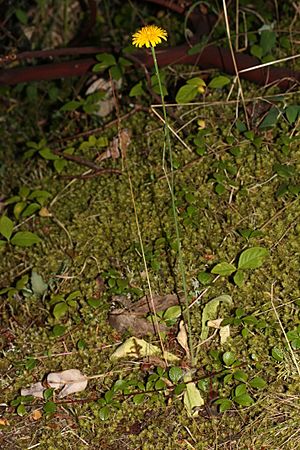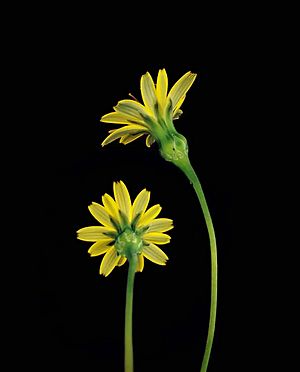Hypochaeris radicata facts for kids
Quick facts for kids Hypochaeris radicata |
|
|---|---|
 |
|
| Hypochaeris radicata (Anacortes Community Forest Lands, Washington) | |
| Scientific classification | |
| Genus: |
Hypochaeris
|
| Species: |
radicata
|
| Synonyms | |
|
Synonymy
Hypochoeris radicata L.
Achyrophorus radicatus (L.) Scop. Achyrophorus taraxacifolius (Salzm.) Sch.Bip. Apargia serotina Jan ex Steud. Crepis molokaiensis H.Lév. Hypochaeris infesta Salisb. Hypochaeris lasiophylla K.Koch ex Nyman Hypochaeris neapolitana DC. Hypochaeris salina Gren. Hypochaeris tenorii Guss. Leontodon ciliatus Scop. Porcellites radicata (L.) Cass. Seriola caespitosa Porta Seriola taraxacifolia Salzm. |
|
Hypochaeris radicata is a common plant known by many names. You might hear it called catsear, flatweed, cat's-ear, or false dandelion. It's a perennial plant, meaning it lives for more than two years. You often find this low-lying edible herb growing in lawns.
Catsear is originally from Europe. However, it has been introduced to many other places. These include the Americas, Japan, Australia, and New Zealand. In some of these new places, it can become an invasive weed. For example, it is listed as a noxious weed in the northwestern U.S. state of Washington.
Contents
What is Catsear?
Catsear plants have leaves that can grow up to eight inches (20 cm) long. These leaves are lobed, meaning they have rounded sections. They are also covered in coarse hairs. The leaves grow in a flat circle, called a rosette, around a central taproot.
From the center of the plant, branched stems grow upwards. These stems hold bright yellow flower heads. When the flowers mature, they turn into seeds. Each seed has a "parachute" that helps it float away on the wind. If you cut any part of the plant, a milky sap will come out.
Why is it Called Catsear?
The scientific name Hypochaeris radicata comes from Greek and Latin. "Hypo" means 'under' and "choiros" means 'young pig'. This might be why the name is sometimes spelled Hypochoeris. The word radicata comes from Latin and means 'with obvious roots'.
In English, the name catsear comes from "cat's ear". This is because the shape and fine hairs on the leaves look a bit like a cat's ear.
Catsear vs. Dandelion: What's the Difference?
Catsear is often called "false dandelion" because people easily confuse it with true dandelions. Both plants have similar yellow flowers. Both also produce seeds that float away on the wind.
However, there are some key differences:
- Catsear flower stems are branched and solid.
- Dandelion stems are not branched and are hollow inside.
- Both plants have a rosette of leaves and a central taproot.
- Dandelion leaves have jagged edges.
- Catsear leaves are more lobe-shaped and have hairs.
Even though they look different, both plants can be used in similar ways.
Can You Eat Catsear?
Yes, all parts of the catsear plant are edible! However, people usually harvest the leaves and roots. The leaves have a mild taste. You can eat them raw in salads, steam them, or add them to stir-fries. Some people like to mix them with other vegetables.
Younger leaves are best for eating. Older leaves can become tough and stringy. Unlike dandelion leaves, catsear leaves are rarely bitter. In Crete, Greece, a type of catsear called pachiés or agriorádika is eaten boiled or steamed.
The root of the catsear plant can also be used. You can roast and grind it to make a coffee substitute.
Is Catsear Safe for Animals?
While catsear is generally safe for humans, it's thought that eating too much of it might cause a leg problem in horses.
See also
 In Spanish: Hypochaeris radicata para niños
In Spanish: Hypochaeris radicata para niños
Images for kids



